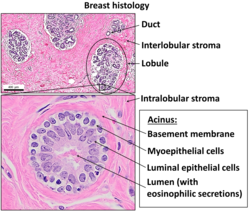| Myoepithelial cell | |
|---|---|
 | |
| Details | |
| Identifiers | |
| Latin | myoepitheliocytus |
| TH | H2.00.02.0.03059 |
| FMA | 67799 67805, 67799 |
| Anatomical terminology | |
Myoepithelial cells (sometimes referred to as myoepithelium) are cells usually found in glandular epithelium as a thin layer above the basement membrane but generally beneath the luminal cells. These may be positive for alpha smooth muscle actin and can contract and expel the secretions of exocrine glands. They are found in the sweat glands, mammary glands, lacrimal glands, and salivary glands. Myoepithelial cells in these cases constitute the basal cell layer of an epithelium that harbors the epithelial progenitor. In the case of wound healing, myoepithelial cells reactively proliferate. Presence of myoepithelial cells in a hyperplastic tissue proves the benignity of the gland and, when absent, indicates cancer. Only rare cancers like adenoid cystic carcinomas contains myoepithelial cells as one of the malignant components.
It can be found in endoderm or ectoderm.[1]
- ^ Jules J. Berman (2009). Neoplasms: principles of development and diversity. Jones & Bartlett Learning. pp. 207–. ISBN 978-0-7637-5570-6. Retrieved 16 April 2010.